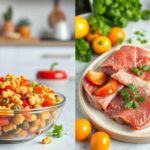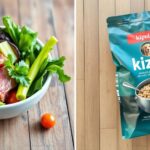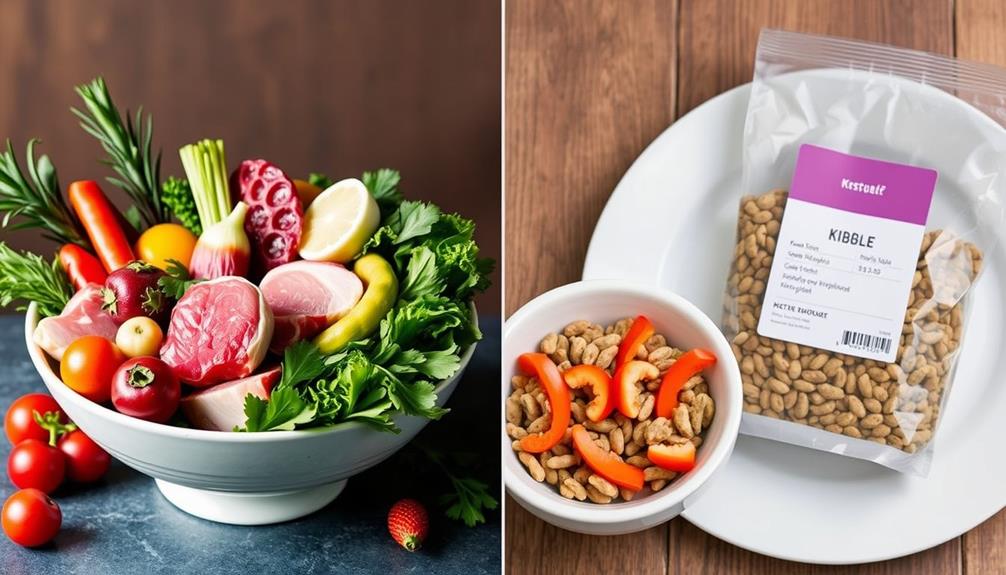When comparing raw food and kibble for your dog, raw diets typically offer higher-quality, easily digestible ingredients with lower carbohydrates and richer vitamins. Dogs on raw diets often experience better overall health and fewer health complications. While kibble is more convenient and usually cheaper upfront, it can contain fillers and high starch levels that might lead to obesity and other health issues. If you consider mixing both, you can enhance your dog's nutrition and ease the shift. Exploring the nuances of these options can guide you in making the healthiest choice for your canine companion. When considering the benefits of kibble vs raw diet, it’s important to weigh the convenience and affordability of kibble against the higher quality and nutritional value of a raw diet. While kibble may be easier to store and feed, it’s crucial to consider the potential long-term health implications for your dog. By understanding the specific nutritional needs of your dog and consulting with a veterinarian, you can make an informed decision that maximizes the benefits of both kibble and raw diet for your pet’s well-being.
Key Takeaways
- Raw food diets provide higher nutrient absorption and lower carbohydrate levels, leading to better overall health in dogs.
- Kibble diets often contain high starch content and processed ingredients, which can contribute to obesity and health issues.
- The initial cost of raw food is higher, but long-term health benefits can reduce veterinary expenses.
- Mixing raw food with kibble allows for enhanced nutrition and easier transition to a raw diet.
- Consulting with veterinary professionals ensures safe handling and appropriate dietary adjustments for dogs transitioning to raw food.
Nutritional Comparison of Diets
When it comes to your dog's diet, the nutritional comparison between raw food and kibble reveals considerable differences. Raw food diets are crafted from high-quality, easily digestible ingredients that offer a balanced, species-appropriate diet.
They're typically low in carbohydrates—usually less than 10%—and rich in natural vitamins, minerals, and amino acids. This composition enhances nutrient absorption due to the bioavailability of raw ingredients. Additionally, raw diets may provide essential hydration benefits, similar to the effects of celery juice overview in promoting hydration.
On the other hand, kibble diets often contain 40-60% carbohydrates, primarily from high-starch sources like rice and corn, which dogs don't need biologically. This can lead to less efficient nutrient utilization and may dilute the nutritional value of their meals.
The extreme heat processing involved in kibble production destroys crucial nutrients and digestive enzymes, further compromising its benefits.
Studies show that dogs on raw meat-based diets (RMBDs) generally have lower alkaline phosphatase and globulin levels, along with higher lymphocyte counts, suggesting better overall health.
In contrast, kibble may include fillers that contribute to health issues like obesity. Ultimately, the choice between these diets can greatly impact your dog's vitality and well-being.
Cost Analysis of Dog Food
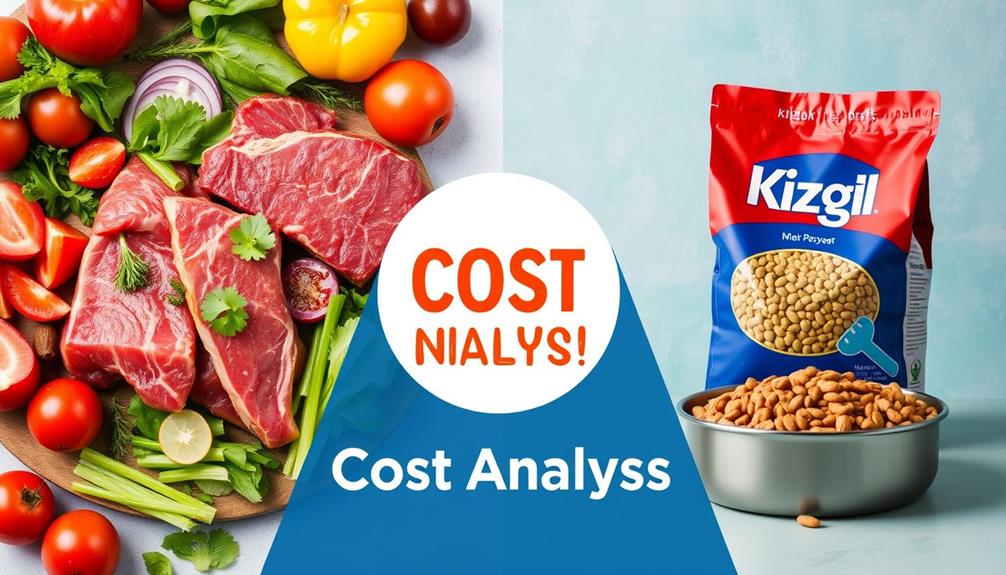
When considering the cost of dog food, you'll find that the initial investment for raw diets is often higher than kibble.
However, the long-term health benefits of raw food can lead to savings on veterinary bills down the road, especially when considering potential health issues linked to poor nutrition.
Additionally, some pet owners report that a gout nutrition guide can be beneficial in understanding how diet impacts overall health.
Plus, don't forget the hidden costs of kibble, which may add up if your dog faces health issues from a less nutritious diet.
Long-Term Health Savings
The long-term health savings associated with your dog's diet can greatly impact your wallet. Investing in raw diets may seem costly upfront, but it often leads to fewer veterinary expenses due to improved health outcomes. Kibble-fed dogs frequently face obesity and related health issues, which can drive up medical costs over time. In contrast, dogs on balanced, species-specific raw diets tend to experience fewer health complications, translating to significant savings in the long run.
Here's a quick comparison of potential costs related to each diet:
| Diet Type | Potential Long-Term Savings |
|---|---|
| Raw Diets | Lower veterinary expenses due to better health outcomes |
| Kibble Diets | Higher veterinary expenses due to obesity and health-related conditions |
Many dogs prefer raw food, enhancing wellness and potentially resulting in further health savings. If you're unsure, hybrid diets incorporating both raw and kibble can help you assess long-term health savings while meeting your dog's nutritional needs. Ultimately, a well-considered choice in diet can lead to both healthier dogs and reduced veterinary expenses.
Initial Investment Comparison
Investing in your dog's diet can feel overwhelming, especially when comparing the costs of raw food versus kibble. The initial investment can vary considerably, which might influence your decision. Here's a breakdown:
- Kibble Diets: Typically, you'll spend between $1 to $13 daily for standard kibble.
- Raw Dog Food: Expect to pay around $3 to $10+ daily for raw options, leading to a higher initial investment. Additionally, understanding common financial terms can help you navigate budgeting for your dog's food effectively.
- Hybrid Feeding: This approach allows you to mix raw food with kibble, gradually introducing raw while potentially lowering daily costs.
Although raw dog food may seem pricier upfront, it could lead to long-term savings. Many owners find that healthier diets can reduce veterinary expenses due to fewer health issues.
Additionally, dogs often prefer raw food, enhancing their mealtime enjoyment, which can encourage a shift despite the cost differences.
Ultimately, aligning your investment with your dog's nutritional needs and considering the potential long-term health benefits can make raw food worth the initial cost. By weighing these factors, you'll be better equipped to make the best choice for your furry friend.
Hidden Costs of Kibble
While kibble may seem like the budget-friendly option for feeding your dog, it's important to contemplate the hidden costs that can arise over time. Though kibble diets typically range from $1 to $13 daily, the high carbohydrate content—40-60%—can lead to obesity and other health issues. These conditions may result in increased vet expenses, potentially negating any initial savings you thought you'd achieved.
Additionally, providing healthy snacks can enhance your dog's overall health and may reduce the likelihood of such health issues.
Many low-quality kibbles contain fillers and artificial preservatives that dilute their nutritional value. This often leads dog owners to purchase supplements or make dietary adjustments, incurring extra costs. If your dog suffers from diet-related health issues due to kibble, the long-term vet bills can quickly add up, making raw diets a more cost-effective choice in the long run.
Investing in a raw diet may seem pricier upfront, but it can promote better overall health and reduce the frequency of vet visits associated with kibble-fed dogs.
Ultimately, while kibble might appear economical initially, the hidden costs may outweigh these savings, making a raw diet a worthwhile consideration for your furry friend's health.
Mixing Raw and Kibble
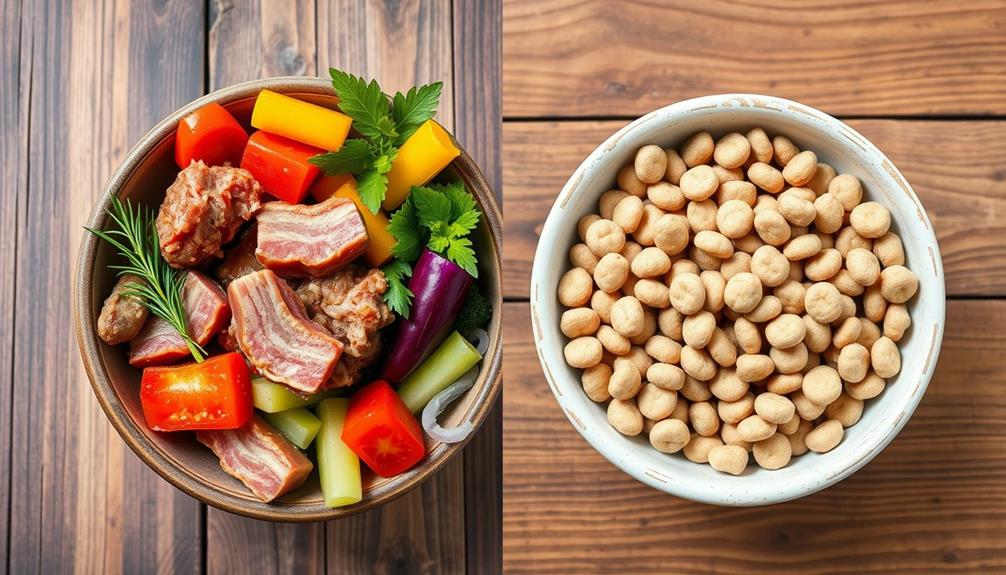
Mixing raw food with kibble can enhance your dog's nutritional balance, but it's important to tailor the ratio to their individual needs.
Incorporating fresh fruits and vegetables into their diet can provide additional vitamins and minerals, much like the proper diet for hamsters.
If you're considering a shift to a raw diet, starting gradually by adding raw as a topper can make the change easier for your dog.
Keep an eye on their health during this adjustment to guarantee they're getting the right nutrients.
Nutritional Balance Considerations
Combining raw food with kibble can offer several nutritional advantages for your dog, but it's important to strike the right balance. While mixing raw food and kibble can enhance your dog's overall wellbeing, it's necessary to take into account their individual nutritional requirements. Here are some key points to keep in mind:
- Ratio Matters: Tailor the raw to kibble ratio based on your dog's specific needs to guarantee a balanced diet. Additionally, many dog owners find thematic coherence in their pet's nutrition by focusing on the types of ingredients used in both raw and kibble formulations.
- Nutritional Density: Raw food is generally more nutritionally dense and species-appropriate compared to kibble, providing crucial nutrients that kibble may lack.
- Health Outcomes: Incorporating even small amounts of raw food can lead to improved health outcomes, but it's important to maintain safety and nutritional adequacy.
Feeding dogs a mixed diet can be beneficial, yet it's significant to monitor their health and adjust the proportions as needed.
Keep in mind that long-term studies on mixed diets are limited, so always stay informed about the latest findings in canine nutrition. By carefully weighing these factors, you can create a balanced approach that meets your dog's unique dietary needs.
Transitioning Gradual Approach
As you consider moving your dog from kibble to a raw food diet, taking a gradual approach can make the process smoother and more effective. Mixing raw food with kibble can be a good starting point, even though it's not the best choice.
Raw food offers superior nutritional benefits compared to kibble's high carbohydrate content and low-quality ingredients, which can sometimes contribute to issues like kidney health maintenance if not monitored properly.
By incorporating raw toppers into kibble meals, you can enhance the overall nutritional profile while your dog adjusts to the new diet. This gradual shift helps reduce the risk of digestive upset and allows you to monitor your dog's response to mixed diets.
Keep an eye on how your dog reacts, since any amount of raw food can boost well-being. As you navigate this process, consider your dog's individual needs and preferences, making adjustments as necessary.
Long-term studies on mixed diets are limited, so it's important to approach this shift thoughtfully. Ultimately, a well-planned gradual change can lead to improved health outcomes, ensuring your furry friend thrives on a primarily raw food diet.
Transitioning to Raw Diet
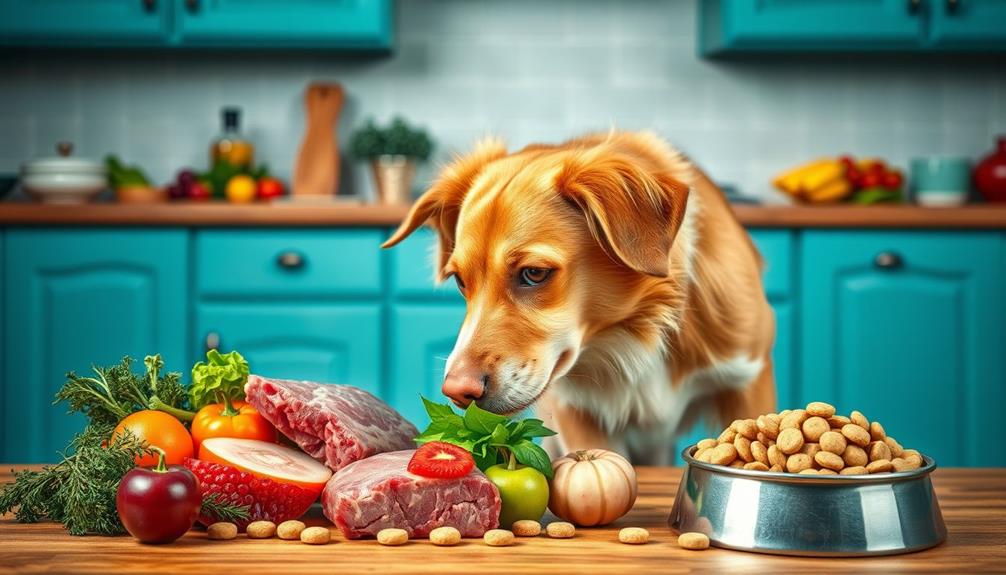
Shifting your dog to a raw diet can be a rewarding experience, but it requires a careful approach. To guarantee a smooth changeover, consider the following steps:
1. Gradual Introduction: Start with varied raw protein sources like chicken, turkey, salmon, and lamb. This helps create a balanced nutrient intake and reduces digestive upset.
Additionally, incorporating essential oils for digestion may support your dog's overall health during this change.
2. Utilize Bone Broth: Warmed bone broth can be beneficial during the changeover. It aids gut adaptation and makes raw food more appealing, especially for dogs hesitant to switch.
3. Monitoring: Keep a close eye on your dog's response throughout the changeover. This is vital for identifying any digestive issues or dietary sensitivities that may arise.
Consulting with a veterinary professional is wise, as opinions on raw diets vary. They can guide you on safe handling and storage practices important for feeding raw food.
Using a raw dog food switching guide can also provide structured support and tips to help you adjust your dog's diet effectively.
With patience and careful monitoring, you can help your dog thrive on a healthy raw diet.
Online Communities and Resources

When you're considering a raw diet for your dog, online communities can be a great source of support.
These platforms often provide best websites to earn money online for dog owners looking to fund their pet's dietary needs.
You can connect with fellow dog owners in forums like "The Pack," where you'll find shared experiences and practical tips.
Plus, plenty of educational resources are available to help you navigate the shift safely and effectively.
Supportive Online Communities
Finding the right support can make all the difference when you're considering a raw food diet for your dog. Supportive online communities can empower you as a dog owner, offering valuable resources and shared experiences that make the change smoother.
These communities often discuss how environmental interactions shape individual development, which can be analogous to how your dog's diet impacts their overall health and behavior.
Here are three key benefits of joining these communities:
- Educational Content: You'll access a wealth of information on raw diets, helping you make informed dietary choices for your pet.
- Shared Best Practices: Engage in discussions with other dog owners who share their tips and insights on raw feeding, ensuring you learn from their experiences.
- Resourceful Insights: Many forums provide insights on the costs and benefits of raw diets, guiding you in weighing your options effectively.
Platforms like "The Pack" foster a sense of belonging, allowing you to connect with others who understand your journey.
Additionally, subscription services like Bella & Duke can streamline your raw feeding experience by providing high-quality options tailored to your dog's needs.
Embrace these supportive online communities, and you'll find yourself better equipped to navigate the world of raw diets with confidence.
Educational Resources Available
Steering through the world of dog nutrition can feel overwhelming, especially when considering a raw food diet.
Fortunately, there are plenty of educational resources available to help you along the way. Online communities like "The Pack" offer invaluable support and shared experiences from fellow pet owners who are either considering or adapting to raw diets. These platforms create a sense of camaraderie as you explore your options.
Subscription services such as Bella & Duke simplify the feeding process by providing tailored raw dog food plans that meet your dog's nutritional needs.
You'll find educational content across various platforms, enabling you to make informed decisions about dietary changes. Additionally, resources detailing the cost and benefits of raw diets allow you to weigh long-term health advantages against the initial investment.
Expert guidance on adapting to raw diets is also readily available, ensuring you navigate the complexities of dietary adjustments while prioritizing your dog's health.
Whether you're comparing raw diets with commercial dog food or seeking adaptive guidance, these resources empower you to provide the best nutrition for your furry friend.
Fresh Food Options for Dogs

Fresh food options for dogs offer a tasty and nutritious alternative to traditional kibble, featuring natural ingredients like beef, chicken, and vegetables.
These fresh food diets can lead to healthier dogs, showcasing benefits like enhanced heart health, shinier coats, better breath, and improved digestion. The high-quality, minimally processed ingredients play a vital role in promoting overall well-being.
If you're considering incorporating fresh food into your dog's diet, here are three key points to keep in mind:
- Consult Vet Nutritionists: Before creating homemade fresh meals, it's important to consult with veterinary nutritionists. They'll help guarantee your dog's nutritional needs are met.
- Time and Financial Commitment: Preparing fresh, balanced meals can be labor-intensive and may require a significant investment.
- Convenient Options Available: Subscription services like Ollie offer pre-portioned, human-grade meals delivered directly to pet owners, simplifying the process of feeding fresh food to dogs.
What to Look for in Fresh Food
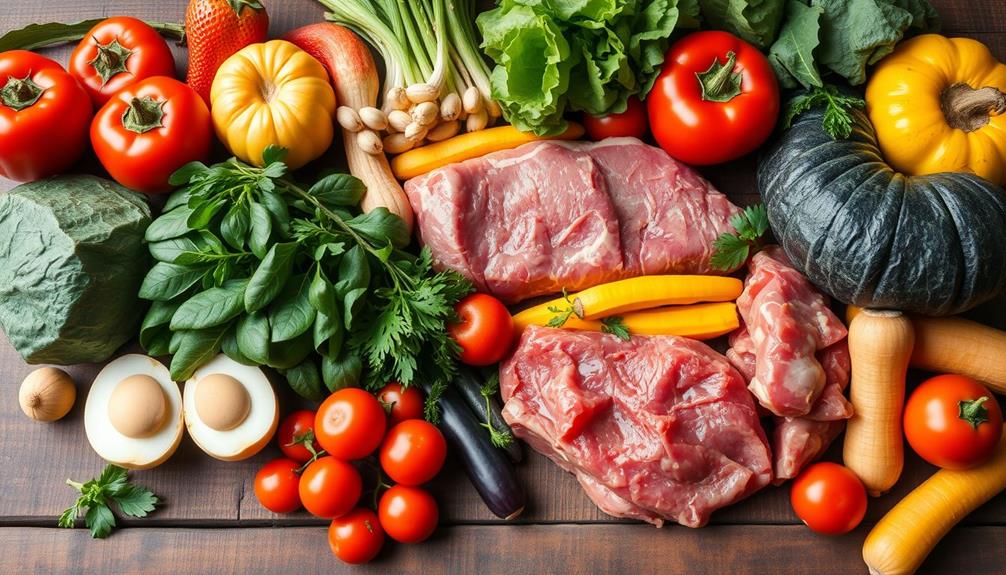
When choosing fresh food for your dog, it's important to prioritize quality and nutritional balance. Look for fresh foods that are made with high-quality ingredients, as they play an essential role in your dog's overall health.
Customized meal plans are often offered through subscription services, allowing you to tailor your dog's diet based on their specific dietary needs. This guarantees balanced nutrition that meets their unique requirements.
Pay attention to the ingredient list; it should be clear and transparent, highlighting the nutritional benefits of each component. Understanding what goes into your dog's meals will empower you to make informed choices.
Additionally, consider the options for recipe choices, portion sizes, and delivery frequency, which can help you maintain a flexible feeding schedule.
Lastly, make sure that the food is prepared and stored safely to preserve its freshness. Providers should offer guidelines on proper handling to keep the meals safe for consumption.
Collaboration with veterinary nutritionists is crucial, as it assures that the fresh foods meet dietary adequacy standards, supporting your dog's health and well-being.
Understanding Raw Diet Components
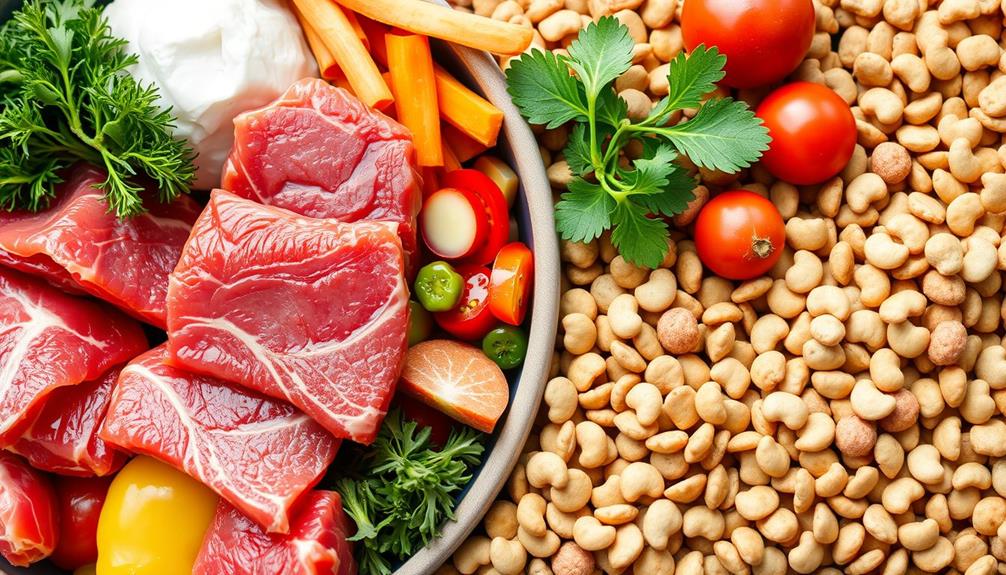
Choosing a raw diet for your dog involves understanding its key components to guarantee a balanced and nutritious meal plan. A well-structured raw dog food (RMBD) typically includes:
- Meat: This consists of both muscle meats and organ meats, which are fundamental for providing high-quality protein and essential nutrients.
- Fruits and Vegetables: Dog-safe options like carrots and blueberries add fiber, antioxidants, and vitamins, contributing to overall health.
- Bones: Raw bones are significant for dental health and provide necessary minerals, but always confirm they're appropriate for your dog's size and chewing ability.
Raw diets are biologically appropriate, containing low carbohydrate levels (under 10%) and higher animal ingredient percentages (70-80%) compared to kibble's higher carb content (40-60%).
Advocates argue that raw diets improve digestion, enhance coat shine, and boost overall vitality due to the higher bioavailability of nutrients.
However, it's essential to consult with veterinary nutritionists when formulating homemade raw meals to guarantee they're balanced and meet all nutritional requirements.
Evaluating Kibble Quality
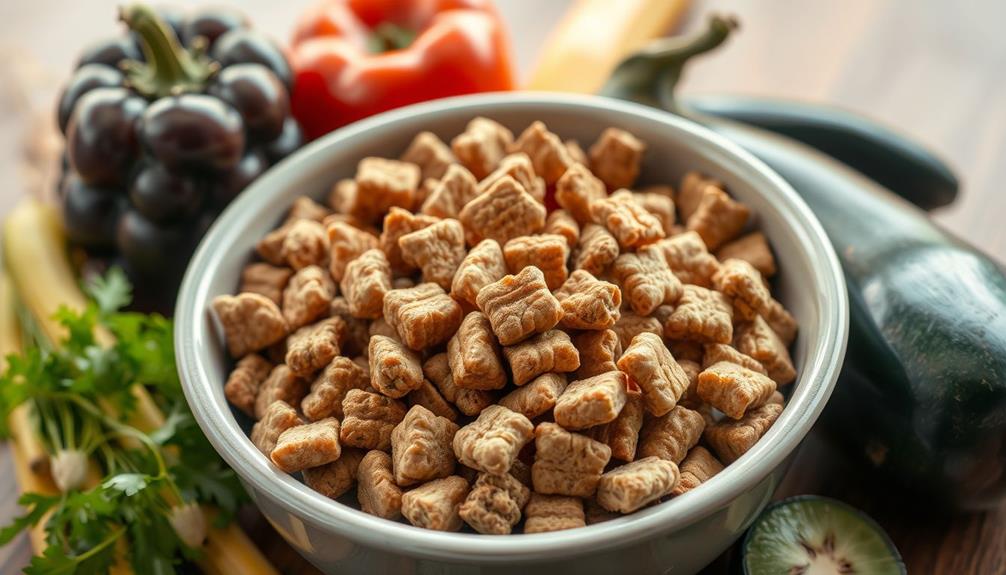
Evaluating kibble quality is essential for ensuring your dog receives a balanced diet that meets its nutritional needs. When choosing commercial kibble, look for high-quality ingredients to avoid health risks associated with low-quality brands. Although kibble must adhere to USDA regulations, not all options are created equal.
| Kibble Quality | Ingredients to Look For | Red Flags |
|---|---|---|
| High-Quality | Real meat, whole grains, | Low-quality ingredients, |
| fresh fruits and veggies | excessive carbohydrates | |
| Medium-Quality | Meat byproducts, grains | High-carb content (over 50%) |
| Low-Quality | Fillers like corn or rice | No clear protein source |
Be cautious of kibble with high-carbohydrate content, often derived from starch-heavy sources that dogs don't need biologically. High-heat processing can strip away crucial nutrients and enzymes, further diminishing the kibble's nutritional value. Over time, poor-quality kibble may lead to obesity and cardiovascular issues in dogs. Prioritize quality to keep your furry friend healthy and thriving.
Historical Overview of Dog Food
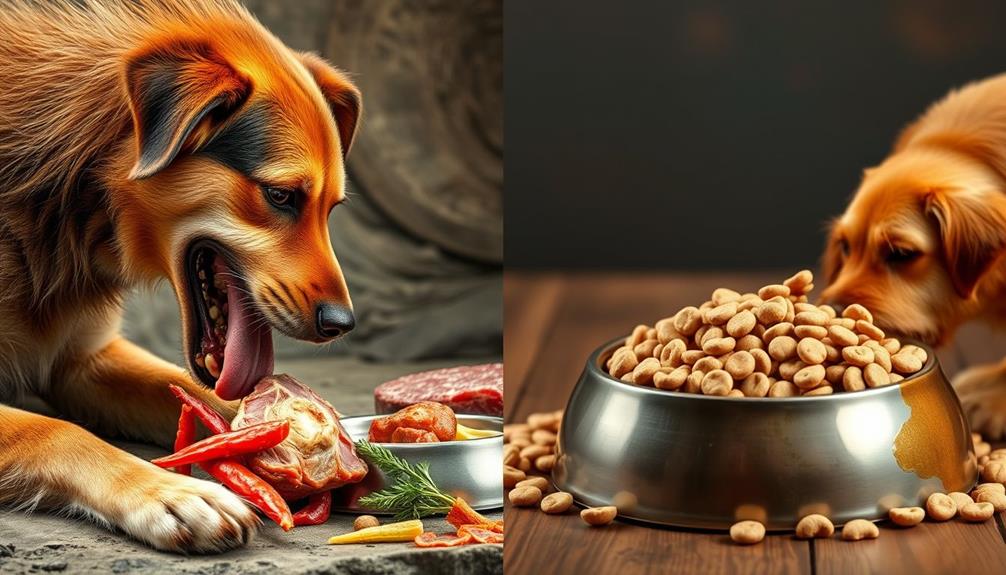
The evolution of dog food reflects humanity's long-standing relationship with dogs as companions and caretakers. The history of dog food began in the late 1800s when James Spratt created the first dog biscuit, which combined vegetables, wheat, and blood. This was just the start of a journey that transformed how we feed our furry friends.
Here's a brief overview of key milestones in dog food history:
- 1920s-1930s: The F.H. Bennett Biscuit Company introduced the first dry dog food, while the Chappel Brothers developed canned wet food.
- 1940s: Due to metal shortages during World War II, the focus shifted from canned food to bagged dry food, leading to the commercialization of kibble.
- 1950s: The launch of Purina Dog Chow marked a significant advancement in dry dog food production and marketing.
Today, the pet food industry offers an array of options, from raw food to kibble, reflecting evolving dietary preferences and health consciousness among pet owners.
Understanding this history helps you appreciate the choices available for feeding your dog.
Frequently Asked Questions
Is Kibble or Raw Food Better for Dogs?
When considering what's better for your dog, think about their digestion and health. Raw food often offers more nutrients and promotes better overall health, while kibble can lead to obesity and low-quality nutrition.
Do Vets Recommend Kibble or Fresh Food?
Over 90% of dogs on raw diets show nutritional deficiencies, so vets often recommend high-quality kibble for its convenience and balance. They may also suggest mixing both to meet your dog's specific needs effectively.
Do Vets Recommend a Raw Diet for Dogs?
Veterinarians' views on raw diets vary. While some support them when balanced properly, others caution against nutritional deficiencies and health risks. It's best to consult a veterinary nutritionist before deciding if a raw diet's right for your dog.
What Is Better for Dogs Kibble or Fresh Food?
When choosing between kibble and fresh food for your dog, consider their health, convenience, and your budget. Fresh food often offers better nutrition, but it requires more preparation and investment than the straightforward option of kibble.
Conclusion
In weighing raw food versus kibble, remember that your dog's health is paramount. Did you know that a study found dogs on a raw diet had a 30% lower risk of developing obesity? This statistic highlights the potential benefits of fresh food for your furry friend. Whether you choose raw or kibble, prioritize quality and nutrition. Ultimately, your dog deserves the best, so explore what works for them and enjoy the journey towards a healthier lifestyle together!



